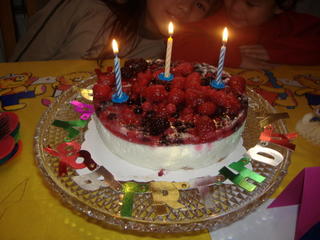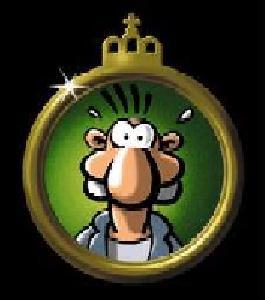Freitag, Oktober 28, 2005
Der echte Champion / The real champion

... wenn er am Anfang nur nicht soviel technische Probleme gehabt hätte ...
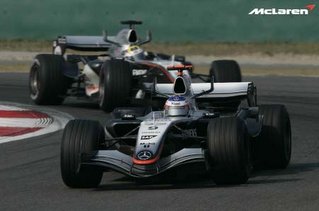
... if he didn't have so many technical problems at the beginning ...
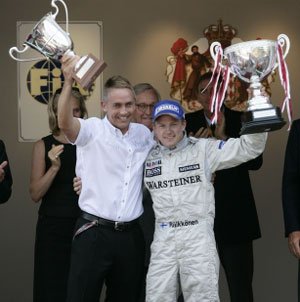
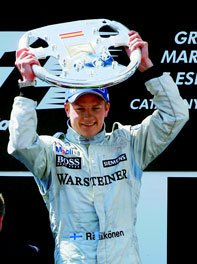
So sehe ich dich am Liebsten! / This is how I love to see you!
 Kimi, die besten Wünsche für die Saison 2006!!!
Kimi, die besten Wünsche für die Saison 2006!!!Kimi, the best wishes for the season 2006!!!


Alle Bilder von www.mclaren.com / All pictures from www.mclaren.com
Musik: Grip - Silver Arrow (Offizielles Lied von Mercedes-Benz Motorsport)
Music: Grip - Silver Arrow (Official song from Mercedes-Benz Motorsport)
[Red Flame 398 41155]
Dienstag, Oktober 25, 2005
FUCK FOR TÜV
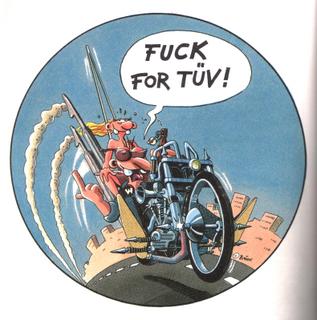
Leider müssen wir uns in Deutschland mit dem TÜV herumärgern.
Unfortunatly we have to be annoyed with the TÜV in Germany.
Zum Glück gibt es nicht überall auf der Welt einen TÜV.
Fortunately a TÜV is not everywhere on the world.

Der Besitzer dieses Owner's Jeeps träumt von einem Mercedes-Benz 300 SL Flügeltürer.
The Owner of this Owner's Jeep dreams of a Mercedes-Benz 300 SL Gullwing.
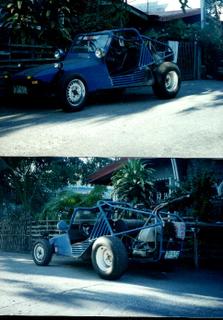
Dieser selbstgebaute Buggy auf VW-Käfer-Chassis ist der Alptraum jedes TÜV-Prüfers. Bemerkenswert ist die vier-in-eins-Auspuffanlage.
This selfmade Buggy on a Chassis of a VW Beetle is the nightmare of all TÜV-Inspectors. Remarkable is the four-in-one-exhaust pipe.
Hier sind noch zwei Owner's Jeeps. Ich möchte jetzt noch nicht alle meine Bilder zeigen ...

Here are two more Owner's Jeeps. I don't want to show all my pictures yet ...
Freitag, Oktober 21, 2005
Unser Kürbis / Our Pumpkin
 Der Anfang / The Beginning
Der Anfang / The Beginning Wo bist du? / Where are you?
Wo bist du? / Where are you? später ... / later ...
später ... / later ... noch später ... / still later ...
noch später ... / still later ...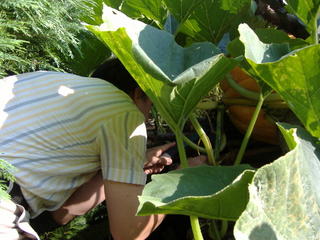 Erntezeit / Harvest Time
Erntezeit / Harvest Time Ups - 1,53 m Umfang und 46,5 kg schwer ... / Oops - 1,53 m circumference and a weight of 46,5 kg ...
Ups - 1,53 m Umfang und 46,5 kg schwer ... / Oops - 1,53 m circumference and a weight of 46,5 kg ...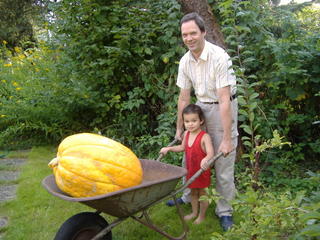 ... unmöglich allein zu tragen! / ... impossible to carry alone!
... unmöglich allein zu tragen! / ... impossible to carry alone!Mittwoch, Oktober 19, 2005
The oldest celebration in Germany
Purchase Intoxication and Play-rubbed: The History Of The Bremen Free Market
At beginning was … the “free market economy”!

When it becomes dark outside and uncomfortable, the Bremen people look forward to the “5th season”, which sells all blue thoughts with multicoloured lights, wonderful smells and merry music: “It’s Free Market!” it means in the autumn. The roots of the Bremen free market lie in the Middle Ages. The oldest German people celebration began on October 16th, 1035, when emperor Konrad II. lent the fair justice to the Bremen archbishop Bezelin. Since this memorable autumn day the city had permission for holding market twice a year on the churchyard “Our Beloved Women”. Without each restriction and consideration to the native guilds, Kramer and moving people could sell their goods now – a newly won economical independence, of which still today the name "free market" reminds.
From 1035 on each following emperor renewed the fair privilege regularly. Franz II. was the latter who gave this permission to the Bremen merchants in 1793. Afterwards the Hanseatic people decided themselves, whether and when they wanted to hold market. And they actually wanted always.
From merchandise market to funfair
At the beginning, most of all shopkeepers and moving people went to the Free Market with their goods. They made special sales volume in fall in harvest time, when many farmers came into the city to make their purchases for the winter.
With the introduction of the driving people into the market live became exciting multicolored. Gambler, magicians, fortune teller, clowns and market shouters offered an amazing world of superlatives: the finest cloth, the noblest spices, the sturdiest jokes – and of course the latest gossip from the world out of the borders of the city and the country.
For a few ten-pfennig pieces one could smell the fragrance of adventure and the world. A lion in the high north? In 1445 it already was on the Bremen market place to be admired. More and more exotic animals were added since the 17th century: trained bears, dromedaries and monkeys, up to the first carnivore cage brought by the entrepreneur Amigoni in 1810. From the 17th to 19th century the humans in their whole skurrilitaet were popular exhibition objects: on the free market gave a guest performance with others the “Hottentott” from Africa (1687), the 68 cm “small Mademoiselle” (1799), which was delivered in a small box when desired, “Buffalo Bills Wild West Company” (1890) and the “lion human being Lionel” with hairs all over his body (1938).
Despite driving people the free market remained nearly 800 years long a produce market. Only since the beginning of the last century the picture changed itself to what we understand today by "fair": with huts, tents and roundabouts developed a celebration of the joy and the pleasure developed. 1809 the first showman with a roundabout appeared. The public was inspired by the wooden horses, which turned, from people strength propelled, in the circle.

Most of all the free market went through a large upswing after the first railroads opened from the middle of the 19th century with always new attractions: 1847 inspired "strike to the Lukas" above all the workers, the lyra box men ensured starting from 1870 for tendency, the ship roundabout swung since 1881 at the place and on the driving downhill and mountain starting from 1890 young humans met. Particularly the youth liked the funfair, because during the whole free market time the afternoon lessons were cancelled completely until 1875.
The market surface increased in the course of time and extended from the cathedral yard and the town hall square as far as the railroad station yard, into the Remberti-quarter (1862), Hohenlohestreet (1889). By the compression of the land development in the historical city center of Bremen, the places for the free market became constantly less, so that the free market grew over the tar yard into the new city (1890).
More and more the new city (Gruenenkamp, Hohentor) became the center of the free market. Up to the year 1933 the free market took place alone in the new city and moved to the Citizen meadow in 1934. Since 1934 the free market takes place on the Citizen meadow, in the heart of the city.
In the 19th century huts with honey cakes and sugar candies became more and more popular. The famous lard cake was available since 1847. And another half century later the fish huts with the popular bacon eels got competition: 1906 the Bremen butcher master Wilhelm Keunecke roasted the first fried sausage on open fire.
When the second world war broke off in 1939, the funfair was allowed only once – as a village of huts on the cathedral yard. Fifty-one years ago the showmen invited to the first, still provisional “peace-“free market.
Free market today: further, higher, more beautiful!

Meanwhile the free market ranks among the most popular and most modern people celebrations in Germany. More than four million visitors from close and far the city can register each year. On a surface of 100.000 square meters 350 showmen offer funfair pleasure of superlative: The newest estimate roundabouts promise the ultimative kick. On no other celebration in Germany you’ll find as many roundabouts as on the Bremen free market. The legal closing times are cancelled during the whole 17 days. sugar candies and smoked eel, colourful light cascades and the ultimative kick, party-tumble and play-rubbed: The “cool Bremen” is in state of emergency: “It’s free market!”
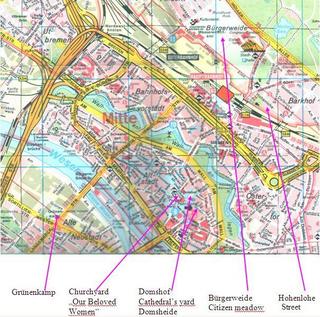
At beginning was … the “free market economy”!

When it becomes dark outside and uncomfortable, the Bremen people look forward to the “5th season”, which sells all blue thoughts with multicoloured lights, wonderful smells and merry music: “It’s Free Market!” it means in the autumn. The roots of the Bremen free market lie in the Middle Ages. The oldest German people celebration began on October 16th, 1035, when emperor Konrad II. lent the fair justice to the Bremen archbishop Bezelin. Since this memorable autumn day the city had permission for holding market twice a year on the churchyard “Our Beloved Women”. Without each restriction and consideration to the native guilds, Kramer and moving people could sell their goods now – a newly won economical independence, of which still today the name "free market" reminds.
From 1035 on each following emperor renewed the fair privilege regularly. Franz II. was the latter who gave this permission to the Bremen merchants in 1793. Afterwards the Hanseatic people decided themselves, whether and when they wanted to hold market. And they actually wanted always.
From merchandise market to funfair
At the beginning, most of all shopkeepers and moving people went to the Free Market with their goods. They made special sales volume in fall in harvest time, when many farmers came into the city to make their purchases for the winter.
With the introduction of the driving people into the market live became exciting multicolored. Gambler, magicians, fortune teller, clowns and market shouters offered an amazing world of superlatives: the finest cloth, the noblest spices, the sturdiest jokes – and of course the latest gossip from the world out of the borders of the city and the country.
For a few ten-pfennig pieces one could smell the fragrance of adventure and the world. A lion in the high north? In 1445 it already was on the Bremen market place to be admired. More and more exotic animals were added since the 17th century: trained bears, dromedaries and monkeys, up to the first carnivore cage brought by the entrepreneur Amigoni in 1810. From the 17th to 19th century the humans in their whole skurrilitaet were popular exhibition objects: on the free market gave a guest performance with others the “Hottentott” from Africa (1687), the 68 cm “small Mademoiselle” (1799), which was delivered in a small box when desired, “Buffalo Bills Wild West Company” (1890) and the “lion human being Lionel” with hairs all over his body (1938).
Despite driving people the free market remained nearly 800 years long a produce market. Only since the beginning of the last century the picture changed itself to what we understand today by "fair": with huts, tents and roundabouts developed a celebration of the joy and the pleasure developed. 1809 the first showman with a roundabout appeared. The public was inspired by the wooden horses, which turned, from people strength propelled, in the circle.

Most of all the free market went through a large upswing after the first railroads opened from the middle of the 19th century with always new attractions: 1847 inspired "strike to the Lukas" above all the workers, the lyra box men ensured starting from 1870 for tendency, the ship roundabout swung since 1881 at the place and on the driving downhill and mountain starting from 1890 young humans met. Particularly the youth liked the funfair, because during the whole free market time the afternoon lessons were cancelled completely until 1875.
The market surface increased in the course of time and extended from the cathedral yard and the town hall square as far as the railroad station yard, into the Remberti-quarter (1862), Hohenlohestreet (1889). By the compression of the land development in the historical city center of Bremen, the places for the free market became constantly less, so that the free market grew over the tar yard into the new city (1890).
More and more the new city (Gruenenkamp, Hohentor) became the center of the free market. Up to the year 1933 the free market took place alone in the new city and moved to the Citizen meadow in 1934. Since 1934 the free market takes place on the Citizen meadow, in the heart of the city.
In the 19th century huts with honey cakes and sugar candies became more and more popular. The famous lard cake was available since 1847. And another half century later the fish huts with the popular bacon eels got competition: 1906 the Bremen butcher master Wilhelm Keunecke roasted the first fried sausage on open fire.
When the second world war broke off in 1939, the funfair was allowed only once – as a village of huts on the cathedral yard. Fifty-one years ago the showmen invited to the first, still provisional “peace-“free market.
Free market today: further, higher, more beautiful!

Meanwhile the free market ranks among the most popular and most modern people celebrations in Germany. More than four million visitors from close and far the city can register each year. On a surface of 100.000 square meters 350 showmen offer funfair pleasure of superlative: The newest estimate roundabouts promise the ultimative kick. On no other celebration in Germany you’ll find as many roundabouts as on the Bremen free market. The legal closing times are cancelled during the whole 17 days. sugar candies and smoked eel, colourful light cascades and the ultimative kick, party-tumble and play-rubbed: The “cool Bremen” is in state of emergency: “It’s free market!”

Das älteste Volksfest in Deutschland
Kaufrausch und Spieltrieb: Die Geschichte des Bremer Freimarkts
Am Anfang war ... die "freie Markt-Wirtschaft"!

Wenn es draußen dunkel und ungemütlich wird, freuen sich die Bremer auf die "5. Jahreszeit", die mit bunten Lichtern, herrlichen Düften und fröhlicher Musik alle grauen Gedanken vertreibt: "Ischa Freimaak!" heißt es im Herbst.
Die Wurzeln des Bremer Freimarktes liegen im Mittelalter. Das älteste deutsche Volksfest begann am 16. Oktober des Jahres 1035, als Kaiser Konrad II. dem bremischen Erzbischof Bezelin die Jahrmarktsgerechtigkeit verlieh. Seit diesem denkwürdigen Herbsttag hatte die Stadt die Erlaubnis, zweimal jährlich Markt auf dem Kirchhof "Unser Lieben Frauen" abzuhalten. Ohne jede Beschränkung und Rücksicht auf die einheimischen Zünfte konnten Kramer und Wandersleute nun ihre Waren verkaufen - eine neu gewonnene wirtschaftliche Unabhängigkeit, an die noch heute der Name "Freimarkt" erinnert.
Von 1035 an hat jeder nachfolgende Kaiser das Jahrmarktsprivileg regelmäßig erneuert. Franz II. war der letzte, der 1793 den Bremer Kaufleuten diese Erlaubnis erteilte. Danach entschieden die Hanseaten selbst, ob und wann sie Markt halten wollten. Und sie wollten eigentlich immer.
Vom Wa(h)renmarkt zum Vergnügungs-Rummel
Zunächst zogen vor allem Krämer und Wandersleute mit ihren Waren zum Freimarkt. Besonderen Umsatz machten die Händler im Herbst zur Erntezeit, wo viele Bauern in die Stadt kamen, um ihre Einkäufe für den Winter zu machen.
Aufregend bunt wurde das Markttreiben mit dem Einzug des fahrenden Volkes. Spielleute, Gaukler, Wahrsager, Possenreißer und Marktschreier boten eine blendende Welt der Superlative: das feinste Tuch, die edelsten Gewürze, die derbsten Zoten - und natürlich der neueste Klatsch aus der Welt jenseits der Stadt- und Landesgrenzen.
Für ein paar Groschen konnte man hier den Duft des Abenteuers und der weiten Welt schnuppern. Ein Löwe im hohen Norden? Bereits 1445 war er auf dem Bremer Marktplatz zu bestaunen. Seit dem 17. Jahrhundert kamen immer mehr exotische Tiere dazu: dressierte Bären, Dromedare und Affen, bis hin zur ersten Raubtier-Menagerie des Unternehmers Amigoni 1810. Vom 17. bis in 19. Jahrhundert war der Mensch in seiner ganzen Skurrilität ein beliebtes Ausstellungsobjekt: auf dem Freimarkt gastierten unter anderem der "Hottentott" aus Afrika (1687), die 68 cm "kleine Mademoiselle" (1799), die auf Wunsch auch in einem kleinen Kasten frei Haus geliefert wurde, "Buffalo Bills Wild West Company" (1890) und der am ganzen Körper behaarte "Löwenmensch Lionel" (1938).
Trotz fahrenden Volkes blieb der Freimarkt fast 800 Jahre lang vor allem ein Warenmarkt. Erst seit Anfang des vorigen Jahrhunderts wandelte sich das Bild zu dem, was wir heute unter "Jahrmarkt" verstehen: Mit Buden, Zelten und Fahrgeschäften entsteht ein Fest der Freude und des Vergnügens. 1809 erschien der erste Schausteller mit einem Karussell. Das Publikum war begeistert von den hölzernen Pferden, die sich, von Menschenkraft angetrieben, im Kreis drehten.
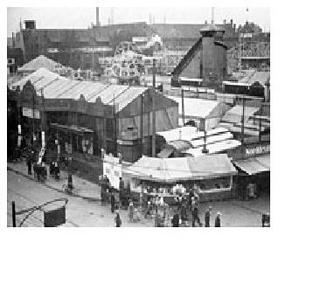
Vor allem nachdem ab Mitte des 19. Jahrhunderts die ersten Eisenbahnstrecken eröffnet wurden, erlebte der Bremer Freimarkt einen großen Aufschwung mit immer neuen Attraktionen: 1847 begeisterte der "Hau den Lukas" vor allem die Arbeiter, die Leierkastenmänner sorgten ab 1870 für Stimmung, das Schiffskarussell schaukelte seit 1881 auf dem Platz und auf der Berg- und Talfahrt trafen sich ab 1890 junge Menschen zum Stelldichein. Besonders bei der Jugend wurde der Rummel beliebt. Während der gesamten Freimarktszeit fiel bis 1875 nämlich der Nachmittagsunterricht in allen Schulen komplett aus.
Die Marktfläche wuchs im Laufe der Jahrhunderte immer mehr an und erweiterte sich auf den Domshof, den Rathausplatz und die Domsheide bis hin zum Bahnhofsplatz, ins Rembertiviertel (1862), Hohenloherstraße (1889). Durch die Verdichtung der Bebauung in der historischen Innenstadt wurden hier die Plätze für den Freimarkt ständig weniger, so dass sich der Freimarkt über den Teerhof in die Neustadt (1890) ausdehnte.
Mehr und mehr wurde die Neustadt (Grünenkamp, Hohentor) zum Mittelpunkt des Freimarktes. Bis zum Jahr 1933 fand der Freimarkt allein in der Neustadt statt, um dann 1934 auf die Bürgerweise zu ziehen. Seit 1934 findet der Freimarkt auf einem Festplatz im Herzen der Stadt, der Bürgerweide, statt.
Im 19. Jahrhundert wurden auch Buden mit Honigkuchen und Zuckerwatte immer beliebter. Den berühmten Schmalzkuchen gab es ab 1847 zu kaufen. Und ein weiteres halbes Jahrhundert später bekamen die Fischbuden mit den beliebten Speckaalen Konkurrenz: 1906 briet der Bremer Schlachtermeister Wilhelm Keunecke die erste Rostbratwurst auf offenem Feuer.
Als 1939 der zweite Weltkrieg ausbrach, wurde das Volksfest nur noch einmal zugelassen - als Budenstadt auf dem Domshof. Vor einundfünfzig Jahren dann luden die Marktbezieher zum ersten noch provisorischen "Friedens-"Freimarkt.
Freimarkt heute: Weiter, höher, schöner!

Mittlerweile zählt der Freimarkt zu den beliebtesten und modernsten Volksfesten in Deutschland. Über vier Millionen Besucher von nah und fern kann die Stadt jedes Jahr verzeichnen. Auf einer Fläche von 100.000 Quadratmetern bieten 350 Schausteller Jahrmarktsvergnügen der Superlative: Die neuesten Überschlagkarussells versprechen Nervenkitzel pur. Auf keinem anderen Fest in Deutschland stehen so viele Fahrgeschäfte wie auf dem Bremer Freimarkt. Die Sperrzeiten für Gaststätten sind während der gesamten 17 Tage aufgehoben. Zuckerwatte und Räucheraal, Lichtkaskaden und Nervenkitzel, Partytaumel und Spielrausch: Das "kühle Bremen" zeigt sich im Ausnahmezustand: "Ischa Freimaak!"
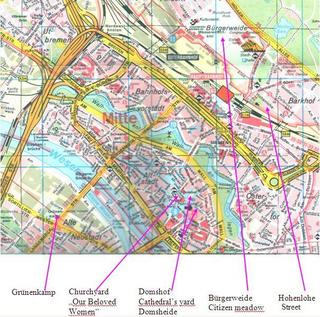
Am Anfang war ... die "freie Markt-Wirtschaft"!

Wenn es draußen dunkel und ungemütlich wird, freuen sich die Bremer auf die "5. Jahreszeit", die mit bunten Lichtern, herrlichen Düften und fröhlicher Musik alle grauen Gedanken vertreibt: "Ischa Freimaak!" heißt es im Herbst.
Die Wurzeln des Bremer Freimarktes liegen im Mittelalter. Das älteste deutsche Volksfest begann am 16. Oktober des Jahres 1035, als Kaiser Konrad II. dem bremischen Erzbischof Bezelin die Jahrmarktsgerechtigkeit verlieh. Seit diesem denkwürdigen Herbsttag hatte die Stadt die Erlaubnis, zweimal jährlich Markt auf dem Kirchhof "Unser Lieben Frauen" abzuhalten. Ohne jede Beschränkung und Rücksicht auf die einheimischen Zünfte konnten Kramer und Wandersleute nun ihre Waren verkaufen - eine neu gewonnene wirtschaftliche Unabhängigkeit, an die noch heute der Name "Freimarkt" erinnert.
Von 1035 an hat jeder nachfolgende Kaiser das Jahrmarktsprivileg regelmäßig erneuert. Franz II. war der letzte, der 1793 den Bremer Kaufleuten diese Erlaubnis erteilte. Danach entschieden die Hanseaten selbst, ob und wann sie Markt halten wollten. Und sie wollten eigentlich immer.
Vom Wa(h)renmarkt zum Vergnügungs-Rummel
Zunächst zogen vor allem Krämer und Wandersleute mit ihren Waren zum Freimarkt. Besonderen Umsatz machten die Händler im Herbst zur Erntezeit, wo viele Bauern in die Stadt kamen, um ihre Einkäufe für den Winter zu machen.
Aufregend bunt wurde das Markttreiben mit dem Einzug des fahrenden Volkes. Spielleute, Gaukler, Wahrsager, Possenreißer und Marktschreier boten eine blendende Welt der Superlative: das feinste Tuch, die edelsten Gewürze, die derbsten Zoten - und natürlich der neueste Klatsch aus der Welt jenseits der Stadt- und Landesgrenzen.
Für ein paar Groschen konnte man hier den Duft des Abenteuers und der weiten Welt schnuppern. Ein Löwe im hohen Norden? Bereits 1445 war er auf dem Bremer Marktplatz zu bestaunen. Seit dem 17. Jahrhundert kamen immer mehr exotische Tiere dazu: dressierte Bären, Dromedare und Affen, bis hin zur ersten Raubtier-Menagerie des Unternehmers Amigoni 1810. Vom 17. bis in 19. Jahrhundert war der Mensch in seiner ganzen Skurrilität ein beliebtes Ausstellungsobjekt: auf dem Freimarkt gastierten unter anderem der "Hottentott" aus Afrika (1687), die 68 cm "kleine Mademoiselle" (1799), die auf Wunsch auch in einem kleinen Kasten frei Haus geliefert wurde, "Buffalo Bills Wild West Company" (1890) und der am ganzen Körper behaarte "Löwenmensch Lionel" (1938).
Trotz fahrenden Volkes blieb der Freimarkt fast 800 Jahre lang vor allem ein Warenmarkt. Erst seit Anfang des vorigen Jahrhunderts wandelte sich das Bild zu dem, was wir heute unter "Jahrmarkt" verstehen: Mit Buden, Zelten und Fahrgeschäften entsteht ein Fest der Freude und des Vergnügens. 1809 erschien der erste Schausteller mit einem Karussell. Das Publikum war begeistert von den hölzernen Pferden, die sich, von Menschenkraft angetrieben, im Kreis drehten.

Vor allem nachdem ab Mitte des 19. Jahrhunderts die ersten Eisenbahnstrecken eröffnet wurden, erlebte der Bremer Freimarkt einen großen Aufschwung mit immer neuen Attraktionen: 1847 begeisterte der "Hau den Lukas" vor allem die Arbeiter, die Leierkastenmänner sorgten ab 1870 für Stimmung, das Schiffskarussell schaukelte seit 1881 auf dem Platz und auf der Berg- und Talfahrt trafen sich ab 1890 junge Menschen zum Stelldichein. Besonders bei der Jugend wurde der Rummel beliebt. Während der gesamten Freimarktszeit fiel bis 1875 nämlich der Nachmittagsunterricht in allen Schulen komplett aus.
Die Marktfläche wuchs im Laufe der Jahrhunderte immer mehr an und erweiterte sich auf den Domshof, den Rathausplatz und die Domsheide bis hin zum Bahnhofsplatz, ins Rembertiviertel (1862), Hohenloherstraße (1889). Durch die Verdichtung der Bebauung in der historischen Innenstadt wurden hier die Plätze für den Freimarkt ständig weniger, so dass sich der Freimarkt über den Teerhof in die Neustadt (1890) ausdehnte.
Mehr und mehr wurde die Neustadt (Grünenkamp, Hohentor) zum Mittelpunkt des Freimarktes. Bis zum Jahr 1933 fand der Freimarkt allein in der Neustadt statt, um dann 1934 auf die Bürgerweise zu ziehen. Seit 1934 findet der Freimarkt auf einem Festplatz im Herzen der Stadt, der Bürgerweide, statt.
Im 19. Jahrhundert wurden auch Buden mit Honigkuchen und Zuckerwatte immer beliebter. Den berühmten Schmalzkuchen gab es ab 1847 zu kaufen. Und ein weiteres halbes Jahrhundert später bekamen die Fischbuden mit den beliebten Speckaalen Konkurrenz: 1906 briet der Bremer Schlachtermeister Wilhelm Keunecke die erste Rostbratwurst auf offenem Feuer.
Als 1939 der zweite Weltkrieg ausbrach, wurde das Volksfest nur noch einmal zugelassen - als Budenstadt auf dem Domshof. Vor einundfünfzig Jahren dann luden die Marktbezieher zum ersten noch provisorischen "Friedens-"Freimarkt.
Freimarkt heute: Weiter, höher, schöner!

Mittlerweile zählt der Freimarkt zu den beliebtesten und modernsten Volksfesten in Deutschland. Über vier Millionen Besucher von nah und fern kann die Stadt jedes Jahr verzeichnen. Auf einer Fläche von 100.000 Quadratmetern bieten 350 Schausteller Jahrmarktsvergnügen der Superlative: Die neuesten Überschlagkarussells versprechen Nervenkitzel pur. Auf keinem anderen Fest in Deutschland stehen so viele Fahrgeschäfte wie auf dem Bremer Freimarkt. Die Sperrzeiten für Gaststätten sind während der gesamten 17 Tage aufgehoben. Zuckerwatte und Räucheraal, Lichtkaskaden und Nervenkitzel, Partytaumel und Spielrausch: Das "kühle Bremen" zeigt sich im Ausnahmezustand: "Ischa Freimaak!"

Sonntag, Oktober 16, 2005
Kindergeburtstag / Children's birthday
Samstag, Oktober 01, 2005
mein Zweitwagen / my second car

Hier ist ein Bild von meinem Zweitwagen. Es ist ein Owner's Jeep mit Toyota-Motor. Ich möchte gerne 'mal damit in Deutschland zum TÜV fahren ...
Here is a picture of my second car. It's an owner's Jeep with engine of Toyota. I'd like to drive it to the TÜV (Technischer Überwachungsverein / Technical Surveillance Union) in Germany ...
Mein neues Hobby
My New Hobby
Hallo!
Hello!
Ich fange jetzt auch einen Weblog an.
Now I start a blog, too.
Ich werde diesen Blog zweisprachig, deutsch und englisch, schreiben.
I'll write this blog bilingual, German and English.
Schau' 'mal wieder 'rein!
Watch it again!
Hello!
Ich fange jetzt auch einen Weblog an.
Now I start a blog, too.
Ich werde diesen Blog zweisprachig, deutsch und englisch, schreiben.
I'll write this blog bilingual, German and English.
Schau' 'mal wieder 'rein!
Watch it again!
